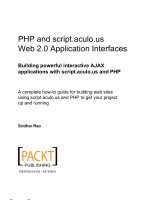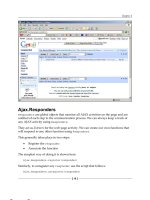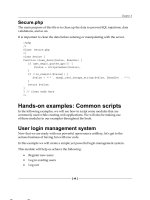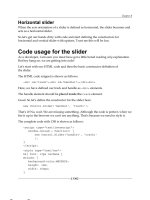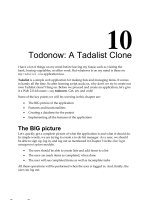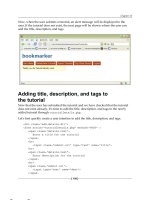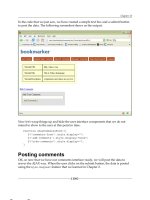Social Web Evolution: Integrating Semantic Applications and Web 2.0 Technologies doc
Bạn đang xem bản rút gọn của tài liệu. Xem và tải ngay bản đầy đủ của tài liệu tại đây (6.88 MB, 340 trang )
Social Web Evolution:
Integrating Semantic Applications
and Web 2.0 Technologies
Miltiadis D. Lytras
Athens University of Economics & Business, Greece
Patricia Ordóñez de Pablos
University of Oviedo, Spain
Hershey • New York
InformatIon scIence reference
Director of Editorial Content: Kristin Klinger
Senior Managing Editor: Jamie Snavely
Managing Editor: Jeff Ash
Assistant Managing Editor: Carole Coulson
Typesetter: Sean Woznicki
Cover Design: Lisa Tosheff
Printed at: Yurchak Printing Inc.
Published in the United States of America by
Information Science Reference (an imprint of IGI Global)
701 E. Chocolate Avenue, Suite 200
Hershey PA 17033
Tel: 717-533-8845
Fax: 717-533-8661
E-mail:
Web site: />and in the United Kingdom by
Information Science Reference (an imprint of IGI Global)
3 Henrietta Street
Covent Garden
London WC2E 8LU
Tel: 44 20 7240 0856
Fax: 44 20 7379 0609
Web site:
Copyright © 2009 by IGI Global. All rights reserved. No part of this publication may be reproduced, stored or distributed in any form or by
any means, electronic or mechanical, including photocopying, without written permission from the publisher.
Product or company names used in this set are for identi.cation purposes only. Inclusion of the names of the products or companies does
not indicate a claim of ownership by IGI Global of the trademark or registered trademark.
Library of Congress Cataloging-in-Publication Data
Social web evolution : integrating semantic applications and Web 2.0 technologies / Miltiadis D. Lytras and Patricia Ordonez de Pablos,
editors.
p. cm.
Includes bibliographical references and index.
Summary: “This book explores the potential of Web 2.0 and its synergies with the Semantic Web and provides state-of-the-art theoretical
foundations and technological applications” Provided by publisher.
ISBN 978-1-60566-272-5 (hardcover) ISBN 978-1-60566-273-2 (ebook) 1. Organizational learning. 2. Knowledge management. 3. Online
social networks. 4. Semantic Web. 5. Web 2.0. I. Lytras, Miltiadis D., 1973- II. Pablos, Patricia Ordonez de.
HD58.82.S66 2009
025.042’7 dc22
2008047729
British Cataloguing in Publication Data
A Cataloguing in Publication record for this book is available from the British Library.
All work contributed to this book is new, previously-unpublished material. The views expressed in this book are those of the authors, but not
necessarily of the publisher.
Social Web Evolution: Integrating Semantic Applications and Web 2.0 Technologies is part of the IGI Global series named Advances in
Semantic Web and Information Systems (ASWIS) Series, ISBN: 1935-3626
If a library purchased a print copy of this publication, please go to for information on activating
the library's complimentary electronic access to this publication.
Social Web Evolution: Integrating Semantic Applications and Web 2.0 Technologies
Edited By: Miltiadis D. Lytras, University of Patras, Greece; Patricia Ordonez de Pablos,
Universidad de Oviedo, Spain
~ Information Science Reference
~ ISBN: 978-1-60566-272-5
~ Copyright 2009
~ Hard Cover
~ Pages: 356
~ Our Price: $195.00
Social Web Evolution: Integrating Semantic Applications and Web 2.0 Technologies explores the potential of
Web 2.0 and its synergies with the Semantic Web and provides state-of-the-art theoretical foundations and techno-
logical applications. A reference edition for academicians, practitioners, policy makers, and government officers ea-
ger for knowledge on Web 2.0 and social Web, this book emphasizes practical aspects of the integration of semantic
applications into social Web technologies. As semantic technologies prove their value with targeted applications,
there are increasing opportunities to consider their usefulness in social contexts for knowledge, learning, and hu-
man development.
Advances in Semantic Web and Information Systems (ASWIS) Series
Editor-in-Chief: Miltiadis Lytras, Athens University of Economics and Business, Greece
ISBN: 1935-3626
e Advances in Semantic Web and Information Systems (ASWIS) Book Series promotes a knowledge transfer
channel where academics, practitioners and researchers can discuss, analyze, criticize, synthesize, communicate,
elaborate, and simplify the more than promising technology of the Semantic Web in the context of Information
Systems. e book series aims to establish value-adding knowledge transfer and personal development channels in
three distinctive areas: Academia, Industry, and Government.
Semantic Web-Based Information Systems: State-of-the-Art Applications
Edited By: Amit Sheth, Wright State University, USA; Miltiadis D. Lytras, University
of Patras, Greece
~ CyberTech Publishing
~ ISBN: 1-59904-426-9
~ Copyright 2007
~ Hard Cover
~ Pages: 317
~ Our Price: $94.95
Semantic Web Information Systems: State-of-the-Art Applications covers new semantic Web-enabled tools for
the citizen, learner, organization, and business. Real-world applications toward the development of the knowledge
society and semantic Web issues, challenges and implications in each of the IS research streams are included as vi-
able sources for this challenging subject.
Order Online at ww.igi-global.com or call 717-533-8845 x100 – Mon-Fri 8:30 AM - 5:00 PM (EST) or
Fax 24 Hours a Day 717-533-8661
To the smiling longskater
- Patricia
Editorial Advisory Board
Miltiadis D. Lytras, University of Patras, Greece
Patricia Ordóñez de Pablos, University of Oviedo, Spain
A. Córdoba, Universidad Pública de Navarra, Spain
Adela Lau, The Hong Kong Polytechnic University, China
Ángel García-Crespo, Universidad Carlos III de Madrid, Spain
Ricardo Colomo-Palacios, Universidad Carlos III de Madrid, Spain
Myriam Mencke, Universidad Carlos III de Madrid, Spain
Juan M. Gómez-Berbís, Universidad Carlos III de Madrid, Spain
Anthony ‘Skip’ Basiel, Middlesex University – IWBL, UK
D. Sandy Staples, Queen’s University, Canada
Daniel Süpke, Carl von Ossietzky Universität Oldenburg, Germany
Jorge Marx Gómez, Carl von Ossietzky Universität Oldenburg, Germany
Diego Berruela, Fundación CTIC, Spain
Eric Tsui, The Hong Kong Polytechnic University, China
F. Echarte, Universidad Pública de Navarra, Spain
Irene Samanta, Technological Education Institute of Piraeus, Greece
J. Villadangos, Universidad Pública de Navarra, Spain
J.J. Astrain, Universidad Pública de Navarra, Spain
Jingyuan Zhao, Harbin Institute of Technology, China
Jose E. Labra, University of Oviedo, Spain
Laszlo Z. Karvalics, University of Szeged, Hungary
Lian Shi, Fundación CTIC, Spain
Paul Coyne, Emerald Group Publishing Ltd, UK
Ralf Isenmann, Fraunhofer Institute for Systems and Innovation Research (ISI), Germany
Preface xvii
Chapter I
Exploring a Professional Social Network System to Support Learning in the Workplace 1
Anthony “Skip” Basiel, Middlesex University – IWBL, UK
Paul Coyne, Emerald Group Publishing Ltd, UK
Chapter II
Knowledge Producing Megamachines: The Biggest Web 2.0 Communities of the Future 17
Laszlo Z. Karvalics, University of Szeged, Hungary
Chapter
III
Web 2.0 Driven Sustainability Reporting 31
Daniel Süpke, Carl von Ossietzky Universität Oldenburg, Germany
Jorge Marx Gómez, Carl von Ossietzky Universität Oldenburg, Germany
Ralf
Isenmann, Fraunhofer Institute for Systems and Innovation Research Karlsruhe, Germany
Chapter IV
Mailing Lists and Social Semantic Web 42
Sergio Fernández, Fundación CTIC, Spain
Diego Berrueta, Fundación CTIC, Spain
Lian Shi, Fundación CTIC, Spain
Jose E. Labra, University of Oviedo, Spain
Patricia Or
dóñez de Pablos, University of Oviedo, Spain
Chapter V
Web 2.0 Social Networking Sites 57
D. Sandy Staples, Queens University, Canada
Chapter
VI
Teachers’ Personal Knowledge Management in China Based Web 2.0 Technologies 76
Jingyuan Zhao, Harbin Institute of Technology, China
Table of Contents
Chapter VII
CUSENT: Social Sentiment Analysis Using Semantics for Customer Feedback 89
Ángel García-Crespo, Universidad Carlos III de Madrid, Spain
Ricar
do Colomo-Palacios, Universidad Carlos III de Madrid, Spain
Myriam Mencke, Universidad Carlos III de Madrid, Spain
Juan M. Gómez-Berbís, Universidad Carlos III de Madrid, Spain
Chapter VIII
Can Knowledge Management Assist Firms to Move from T
raditional to E-Commerce:
The Case of Greek Firms 102
Irene Samanta, Technological Education Institute of Piraeus, Greece
Chapter IX
Knowledge Management and Lifelong Learning in Archival Heritage: Digital Collections
on a Semantic Scope for Educational Potential 116
Trianta.llia Kourtoumi, General State Archives of Greece, Greece
Chapter X
Application of Web 2.0 Technology for Clinical Training 132
Adela Lau, The Hong Kong Polytechnic University, China
Eric T
sui, The Hong Kong Polytechnic University, China
Chapter XI
Pattern Matching Techniques to Identify Syntactic
Variations of Tags in Folksonomies 138
F. Echarte, Universidad Pública de Navarra, Spain
J. J. Astrain, Universidad Pública de Navarra, Spain
A. Córdoba, Universidad Pública de Navarra, Spain
J. Villadangos, Universidad Pública de Navarra, Spain
Chapter XII
Insights into the Impact of Social Networks on Evolutionary Games 150
Katia Sycara, Carnegie Mellon University, USA
Paul Scerri, Carnegie Mellon University
, USA
Anton Chechetka, Carnegie Mellon University
, USA
Chapter XIII
Application of Semantic Web Based on the Domain-Specic Ontology for Global KM 160
Jaehun Joo, Dongguk University, Kor
ea
Sang M. Lee, University of Nebraska – Lincoln, USA
Y
ongil Jeong, Saltlux, Inc., Korea
Chapter XIV
Designing Online Learning Communities to Encourage Cooperation 177
Miranda Mowbray, HP Laboratories Bristol, UK
Chapter XV
Building Virtual Learning Communities 192
Naomi Augar, Deakin University, Australia
Ruth Raitman, Deakin University
, Australia
Elicia Lanham, Deakin University, Australia
Wanlei Zhou, Deakin University
, Australia
Chapter XVI
Support Networks for Rural and Regional Communities 216
Tom Denison, Monash University, Australia
Chapter XVII
Building Virtual Communities through a De-Marginalized View of Knowledge Networking 233
Kam Hou Vat, University of Macau, Macau
Chapter XVIII
A Basis for the Semantic Web and E-Business: Efcient Organization of Ontology Languages
and Ontologies 249
Changqing Li, National University of Singapore, Singapore
T
ok Wang Ling, National University of Singapore, Singapore
Chapter XIX
User
-Centered Design Principles for Online Learning Communities: A Sociotechnical
Approach for the Design of a Distributed Community of Practice 267
Ben K. Daniel, University of Saskatchewan, Canada
David O’Brien, University of Saskatchewan, Canada
Asit Sarkar
, University of Saskatchewan, Canada
Compilation of References 280
About the Contributors 309
Index 318
Preface xvii
Chapter I
Exploring a Professional Social Network System to Support Learning in the Workplace 1
Anthony “Skip” Basiel, Middlesex University – IWBL, UK
Paul Coyne, Emerald Group Publishing Ltd, UK
The authors of this chapter
explore how professionals can network, collaborate and capture informal
learning in an online work-based environment. It addresses the pedagogical approaches that underpin
emerging Web 2.0 technological trends and provide recommendations for future use of such online
environments.
Chapter II
Knowledge Producing Megamachines: The Biggest Web 2.0 Communities of the Future 17
Laszlo Z. Karvalics, University of Szeged, Hungary
This chapter addresses the control crisis of science whose resolution requires radical social innovation.
The only possible way for achieving this is the partial fusion of certain portions of scientic activity
with the system of public education, by means of organizing scientists, teachers, as well as middle and
highschool students into hybrid, knowledge producing mega-machines. The authors of the chapter sub-
sequently argue that doing so will at the same time bring about a pragmatic shift in public education, for
which professionals in the eld of pedagogy have long been ready in principle and in theory.
Chapter III
Web 2.0 Driven Sustainability Reporting 31
Daniel Süpke, Carl von Ossietzky Universität Oldenburg, Germany
Jor
ge Marx Gómez, Carl von Ossietzky Universität Oldenburg, Germany
Ralf
Isenmann, Fraunhofer Institute for Systems and Innovation Research Karlsruhe, Germany
Web 2.0 driven sustainability reporting describes an emerging digital approach powered through Web 2.0
technologies for companies communicating sustainability issues. Such a computer-based application of
Detailed Table of Contents
semantics overcomes the limitations of orthodox methods and provides an array of specic capabilities
to improve sustainability communication both, for companies (reporters), and their various stakeholders
(report readers), that is, along interactivity, customisation ,and reporting à la carte, stakeholder dialogue,
and participation. This chapter gives an outline on this up-and-coming sustainability reporting approach
along three categories: (i) Media-specic trends in sustainability reporting are observed. (ii) New op-
portunities Web 2.0 technologies are offering for corporate sustainability reporting are identied. (iii)
The concept and implementation of a software tool for sustainability reporting à la carte is presented
making clear the movement away from early reporting stages towards the advanced one of a Web 2.0
driven approach.
Chapter IV
Mailing Lists and Social Semantic Web 42
Sergio Fernández, Fundación CTIC, Spain
Diego Berrueta, Fundación CTIC, Spain
Lian Shi, Fundación CTIC, Spain
Jose E. Labra, University of Oviedo, Spain
Patricia Or
dóñez de Pablos, University of Oviedo, Spain
Electronic Mailing lists are a
key part of the Internet. They have enabled the development of social
communities who share and exchange knowledge in specialized and general domains. In this chapter
the authors describe methods to capture some of that knowledge which will enable the development of
new datasets using Semantic Web technologies. In particular, the authors present the SWAML project,
which collects data from mailing lists. The authors also describe smushing techniques that normalize
RDF datasets capturing different resources that identify the same one. They have applied those techniques
to identify persons through the mailing lists of open source communities. These techniques have been
tested using a dataset automatically extracted from several online open source communities.
Chapter V
Web 2.0 Social Networking Sites 57
D. Sandy Staples, Queens University, Canada
This chapter describes one of the Web 2.0 technologies, Social Networking Sites (SNS). A denition of
SNS is offered, as is a short history of these sites. The existing research is reviewed and organized to
summarize what we know about SNS usage (from the perspectives of student use, general population
use and organizational use), and what people know about the antecedents and outcomes of SNS use.
The chapter concludes with discussion of new developments, challenges and opportunities. There are
many opportunities for future research and organizational applications of SNS as SNS adoption grows
at incredible rates.
Chapter VI
Teachers’ Personal Knowledge Management in China Based Web 2.0 Technologies 76
Jingyuan Zhao, Harbin Institute of Technology, China
Knowledge is taken as core competitive power in the current society. The teacher as an educational
operator often touch much knowledge, if they could manage knowledge efciently, the work efciency
will be increased greatly. To mine knowledge and make tacit knowledge explicit, teachers should manage
personal knowledge. By the survey of teachers’ personal knowledge management in China, the study nds
some problems in terms of Chinese teachers’ personal knowledge management, especially many Chinese
teachers are not good at making use of Web technologies to assist them on managing knowledge and
communicating with other teachers. One studying focus of Web 2.0 technologies is personal knowledge
management, and Web 2.0 provides a series of effective tools and platforms for personal knowledge
management. The chapter discusses on the concept of teachers’ personal knowledge management, and
presents the strategies of teachers’ personal knowledge management based Web 2.0 technologies, using
for reference for teachers’ personal knowledge management practice.
Chapter VII
CUSENT: Social Sentiment Analysis Using Semantics for Customer Feedback 89
Ángel García-Crespo, Universidad Carlos III de Madrid, Spain
Ricar
do Colomo-Palacios, Universidad Carlos III de Madrid, Spain
Myriam Mencke, Universidad Carlos III de Madrid, Spain
Juan M. Gómez-Berbís, Universidad Carlos III de Madrid, Spain
The current chapter introduces CUSENT
, a tool for semantics-enhanced sentiment analysis of customer
opinions expressed in corporate blogs. The research work presents the examination of emotions and
sentiments from the perspective of information systems, and, in particular, provides a review of the
principal efforts for the conceptualization of emotions and sentiments in texts. Subsequently, a descrip-
tion of the proposed architecture of the platform is outlined. The authors aim to contribute a solution
which automates the analysis of customer opinions in company blogs that relies on existing techniques,
but further exploits these methods to store and reuse customer feedback. The novel combination of
opinion mining with an ontology of emotions can thus be used in organizational creation and innova-
tion processes, which characterize the new forms of communication derived from the institutional and
commercial use of Web 2.0.
Chapter VIII
Can Knowledge Management Assist Firms to Move from Traditional to E-Commerce:
The Case of Greek Firms 102
Irene Samanta, Technological Education Institute of Piraeus, Greece
This chapter is to dene the rm’s innovative core and create frameworks to integrate innovation
throughout the management of knowledge by generating implementing ideas, strategies and plans ap-
plied that cultivate a thinking organization aims to associate innovation with business targets. It argues
that companies which manage and transform the knowledge effectively reap the rewards of scientic
and technological achievement in order to adopt innovation concept in their operation. Furthermore, the
author hope that rms understanding the information received from the current global business world and
transmit it to reap the rewards of scientic achievement will increase their competitiveness competition
not only for sales, but also for technical know – how and skills. At the company level depends on the
speed with which new products can be brought to the market place and on the importance of achieving
new cost – saving improvements.
Chapter IX
Knowledge Management and Lifelong Learning in Archival Heritage: Digital Collections
on a Semantic Scope for Educational Potential 116
Triantallia Kourtoumi, General State Archives of Greece, Greece
Archives have a key role to play in underpinning learning in its broadest sense, both as a formal activity
within an institution and informally within the community. This is becoming especially important in an
increasingly KM-based environment. This chapter provides an overview of technologies that can be ap-
plied to archival knowledge management. Furthermore, it assesses their actual or potential contribution to
the basic processes of knowledge sharing within archival organizations, with a focus on lifelong learning.
The scope of the rst section (the screens) is to identify new developments that seem to be signicant
and to relate them to technology research in the archival eld. The second section (the frames) discusses
the concepts supporting digital collections by integrating collections of digitized archival resources to
create new services and infrastructures. The third section (the agendas) analyses-from the educational
perspective of lifelong learning-important social benets, both quantitatively and qualitatively, of de-
veloping new infrastructures for accessing and using archival resources.
Chapter X
Application of Web 2.0 Technology for Clinical Training 132
Adela Lau, The Hong Kong Polytechnic University, China
Eric T
sui, The Hong Kong Polytechnic University, China
In clinical training, students
plan, implement and evaluate their learning activities by themselves. They
apply theories and concepts in a real clinical environment and learn through social interaction and reec-
tive thinking to experience, conceptualize, apply and create new knowledge to solve clinical problems.
Since students are sent to different clinical locations for training and are mentored on a one-to-one basis,
it is difcult for students to share their knowledge, make enquiries or interact with their peers and mentors
for social and reective learning. Web 2.0 provides a collaborative and social interactive platform that
allows learners to exchange, share, acquire, codify, distribute, and disseminate knowledge. Its functions
and features are able to construct a virtual and distributed environment for learners to gather, lter and
update the knowledge over different internet sources. This paper thus aims to discuss the functions and
features of Web 2.0 technology and its applications to clinical training.
Chapter XI
Pattern Matching Techniques to Identify Syntactic Variations of Tags in Folksonomies 138
F. Echarte, Universidad Pública de Navarra, Spain
J. J.
Astrain, Universidad Pública de Navarra, Spain
A. Córdoba, Universidad Pública de Navarra, Spain
J. Villadangos, Universidad Pública de Navarra, Spain
Folksonomies offer
an easy method to organize information in the current Web. This fact and their col-
laborative features have derived in an extensive involvement in many Social Web projects. However
they present important drawbacks regarding their limited exploring and searching capabilities, in contrast
with other methods as taxonomies, thesauruses and ontologies. One of these drawbacks is an effect of
its exibility for tagging, producing frequently multiple syntactic variations of a same tag. In this chap-
ter we study the application of two classical pattern matching techniques, Levenshtein distance for the
imperfect string matching and Hamming distance for the perfect string matching, to identify syntactic
variations of tags.
Chapter XII
Insights into the Impact of Social Networks on Evolutionary Games 150
Katia Sycara, Carnegie Mellon University, USA
Paul Scerri, Carnegie Mellon University
, USA
Anton Chechetka, Carnegie Mellon University, USA
The chapter explores the
use of evolutionary game theory (EGT) to model the dynamics of adaptive
opponent strategies for a large population of players. In particular, it explores effects of information
propagation through social networks in evolutionary games. The key underlying phenomenon that the
information diffusion aims to capture is that reasoning about the experiences of acquaintances can dra-
matically impact the dynamics of a society. The chapter presents experimental results from agent-based
simulations that show the impact of diffusion through social networks on the player strategies of an
evolutionary game and the sensitivity of the dynamics to features of the social network.
Chapter XIII
Application of Semantic Web Based on the Domain-Specic Ontology for Global KM 160
Jaehun Joo, Dongguk University, Korea
Sang M. Lee, University of Nebraska – Lincoln, USA
Y
ongil Jeong, Saltlux, Inc., Korea
This chapter introduces an
application of the Semantic Web based on ontology to the tourism business.
Tourism business is one promising area for Semantic Web applications. To realize the potential of the
Semantic Web, we need to nd a killer application of the Semantic Web in the knowledge management
(KM) area. The ontology as a key enabler is deigned and implemented under a framework of the Se-
mantic-Web-driven KM system in a tourism domain. Finally, we discussed the relationship between the
Semantic Web and KM processes.
Chapter XIV
Designing Online Learning Communities to Encourage Cooperation 177
Miranda Mowbray, HP Laboratories Bristol, UK
This chapter is concerned with how to design an online learning community in such a way as to encour-
age cooperation, and to discourage uncooperative or antisocial behavior. Rather than restricting design
to visual and interface issues, the author takes a wide view, touching on aspects of the governance,
social structure, moderation practices, and technical architecture of online learning communities. The
rst half of the chapter discusses why people behave antisocially in online learning communities, and
ways to discourage this through design. The second half discusses why on the other hand people behave
cooperatively in online learning communities, and ways to encourage this through user-centered design,
applying some results of experiments in social psychology. The chapter is intended to be of practical
use to designers of online learning communities.
Chapter XV
Building Virtual Learning Communities 192
Naomi Augar, Deakin University, Australia
Ruth Raitman, Deakin University
, Australia
Elicia Lanham, Deakin University, Australia
Wanlei Zhou, Deakin University
, Australia
This chapter introduces the concept of virtual learning communities and discusses and further enhances
the theory and denitions presented in related literature. A model comprising four criteria essential to
virtual learning communities is presented and discussed in detail. Theory and case studies relating to the
impact of virtual learning communities on distance education and students from diverse cultural groups
are also examined. In addition, this chapter investigates the enabling technologies and facilitation that
is required to build virtual learning communities. Other case studies are used to illustrate the process
of building virtual learning communities. Emerging technologies such as Wikis and video lectures are
also analysed to determine the effects they have on building and sustaining effective virtual learning
communities.
Chapter XVI
Support Networks for Rural and Regional Communities 216
Tom Denison, Monash University, Australia
Using a case study approach, this chapter examines the role of organizational networks in the success
and failure of information and communications technology projects. Within a framework informed by
the literature of information systems failure, the diffusion of innovation and social network analysis;
it argues that information systems projects must take into account the social context in which they are
implemented. To be successful such networks require a mix of extended and locally based support net-
works, because they provide access to much needed resources, including innovations, strategic advice,
training, and support at the appropriate level. It further argues that the people who are working in a
regional setting felt themselves to be in an extremely disadvantageous situation because they typically
lacked support from similar networks. The author hopes that highlighting the importance of such sup-
port networks will lead to a better understanding of systems failure and success, and will contribute to
improved policy formulation and practice.
Chapter XVII
Building Virtual Communities through a De-Marginalized View of Knowledge Networking 233
Kam Hou Vat, University of Macau, Macau
The chapter investigates an actionable context of knowledge networking, from the perspective of sus-
tainable development which should accommodate the building of communities in cyberspace so much
exemplied in today’s Internet and World Wide Web. The premise of this exploration is that members,
or participants, in any community are engaged in learning that is critical to the survival and reproduction
of that community. Through community participation, learners nd and acquire models and have the
opportunity themselves to become models and apprentices of others. This investigation provides a basis
for thinking about the possibilities of a virtual community and the dynamics of its construction across a
variety of computer-based contexts. The design and renement of technology as the conduit for extend-
ing and enhancing the possibilities of virtual community building is an essential issue, but the role of
the individuals as participants in such a community is as important. The idea of sustainable knowledge
networking is to bring about continual learning and change for the community in need. The emergent
challenge of such a mission is to demarginalize many of the non-technical issues of building virtual
communities for knowledge transfer and learning. The chapter concludes by reiterating the challenge
of expositing what it means to create an appropriate context of knowledge networking through which
purposeful actions can be supported with the elaboration of suitable information technologies.
Chapter XVIII
A Basis for the Semantic Web and E-Business: Efcient Organization of Ontology Languages
and Ontologies 249
Changqing Li, National University of Singapore, Singapore
T
ok Wang Ling, National University of Singapore, Singapore
This chapter
introduces how to effectively organize ontology languages and ontologies and how to
efciently process semantic information based on ontologies. In this chapter the authors propose the
hierarchies to organize ontology languages and ontologies. Based on the hierarchy of ontology lan-
guages, the ontology designers need not bear in mind which ontology language the primitives exactly
come from, also we can automatically and seamlessly use the ontologies dened with different ontology
languages in an integrated environment. Based on the hierarchy of ontologies, the conicts in different
ontologies are resolved, thus the semantics in different ontologies are clear without ambiguities. Also,
these semantic-clear ontologies can be used to efciently process the semantic information in Semantic
Web and E-Business.
Chapter XIX
User-Centered Design Principles for Online Learning Communities: A Sociotechnical
Approach for the Design of a Distributed Community of Practice 267
Ben K. Daniel, University of Saskatchewan, Canada
David O’Brien, University of Saskatchewan, Canada
Asit Sarkar
, University of Saskatchewan, Canada
This
chapter aims to introduce user-centered design and its basic concepts associated with online learning
communities. Another aim is to search for guidelines to ensure quality in online learning. Human-com-
puter interaction for education provides the missing holistic approach for online learning. Functioning
in a sociotechnical framework, online learning communities combine information and knowledge stores
situated in shared social spaces using social learning software. In recent years, educational technologists
linked theory and systems design in education. However, several disciplines combine in online learning.
User-centered design provides the cross-disciplinary approach that appears to be essential for quality in
online learning design and engineering. Thus, seven guidelines for experts’ evaluation are proposed as
signposts: intention, information, interactivity, real-time evaluation, visibility, control, and support.
Compilation of References 280
About the Contributors 309
Index 318
xvii
Preface
As semantic technologies prove their value with targeted applications, there are increasing opportunities
to consider their application in social contexts for knowledge, learning, and human development.
Semantic Web and Knowledge Management has been accepted as a critical enabler aiming to in-
crease knowledge-related performance by better use of intellectual assets, in addition to which many
governments are forced to increasingly deal with knowledge services that form larger parts of the global
economy and society.
Thus there are recent examples of applications of semantics for empowering knowledge management
or better supporting knowledge services for social networks. In this edited book we explore the poten-
tial of Web 2.0 and its synergies with Semantic Web, and we provide the state of the art in theoretical
foundations and technological applications. In the context of Social Web Evolution, social and human
issues are of equal if not higher importance than the technical issues that have tended to receive the bulk
of attention in the past. Consequently, chapters that touch these aspects, or those that extend technical
and domain knowledge to social and human issues are especially sought. This is intended to initiate a
dialog between the social, psychological, and technical views of the eld.
Web 2.0 is one of the hottest topics in Information Systems. Currently, the main discussion is empha-
sized on technologies while there is a great demand for editions that will analyze the business models
and business perspectives of the new generation Web. This book is one of the rst attempts to discuss
in an integrated way the business implications of Web 2.0 and its linkage to business value.
Web 2.0, refers to a perceived or proposed second generation of Internet-based services—such as
social networking sites, Wikis, communication tools, mashups and folksonomies—that emphasize on
online collaboration and sharing among users.
Additionally we also include further readings of a complimentary nature to the contents of the rest of
our publication. As an added value to our readers, the further readings are to provide additional related
data in support of the book’s comprehensive concepts, principles and results, as well as studies that build
upon the appeal of this publication as a one-stop reference source.
We do not want to miss this opportunity to say thanks to IGI Global, and in particular to Jan Travers
and Kristin M. Klinger for giving us the opportunity to develop this book. Also thanks to all authors of
chapters, for their interest in collaborating in this book.
Miltiadis D. Lytras
Athens, Greece, October 2008
Patricia Ordóñez de Pablos
Gijón, Spain, October 2008
1
Chapter I
Exploring a Professional
Social Network System to
Support Learning in the
Workplace
Anthony “Skip” Basiel
Middlesex University – IWBL, UK
Paul Coyne
Emerald Group Publishing Ltd, UK
Copyright © 2009, IGI Global, distributing in print or electronic forms without written permission of IGI Global is prohibited.
ABSTRACT
This chapter sets out to explore how professionals can network, collaborate and capture informal learning
in an online work-based environment. It addresses the pedagogical approaches that underpin emerging
Web 2.0 technological trends and provide recommendations for future use of such online environments.
Existing Virtual Learning Environments (VLEs) are primarily content driven with little provision for
social engagement and stakeholder-generated material. Similarly, many organisations have little or no
structure for facilitating online interaction in a work based learning context. Since 2006 Emerald Group
Publishing and the Middlesex Centre for Excellence in Work Based Learning have been partnering to
develop, test and implement an online platform that will support collaborative, interactive learning. This
link between Industry and Higher Education is critically reviewed. The InTouch (2008) platform was
incorporated into the syllabus for MCEWBL’s work-based Professional Practice BA Honours programme
in 2007 to support newly trained professionals as they worked through a professional development work
based learning programme. The pedagogical underpinning of the course was reective, self-directed
2
Exploring a Professional Social Network System to Support Learning in the Workplace
INTRODUCTION
Middlesex University work based learning (WBL)
has been operating for over ten years at the time of
this writing. Its original distance learning design
was a paper-based correspondence model which
relied heavily on the content in the handbooks
and one-to-one (1-2-1) tutorial support from WBL
Learning Development Tutors predominantly
through email and phone feedback. Over the past
few years there has been a steady transition into the
use of a commercial virtual learning environment
(VLE) in the form of Blackboard/WebCT.
At rst this system matched the WBL teaching
and learning design since there was a strong reli-
ance on the course handbook for information and
guidance. However, as student numbers increased
the student-teacher ratio meant this model was not
sustainable for the future. The 1-2-1 pedagogic
model would need to expand into a triad that
would promote and support peer involvement.
Students were growing in their ICT condence
and capability with the increased use of Web 2.0
social network systems such as Facebook and
YouTube. This was evidenced by student repre-
sentatives at the WBL Board of Studies sighting
the need to continue to improve the VLE for the
future (BOS, 2007).
Cohorts of WBL candidates identied the
need for a shift from a content-driven eLearning
system to one which could support the type of
peer review that WBL was growing into. The
WBL programme structure has three main stages.
First, students construct a portfolio of their prior
professional knowledge. This Recognition of Ac-
credited learning (RAL or a.k.a. Accreditation
of Prior Experiential Learning (APEL)) stage
beneted by candidates sharing professional
experiences in constructing their areas of learn-
ing claims (Armsby, 2006). Next, WBL students
would formulate an individual learning agree-
ment that would guide the construction of the
degree programme based on how much Higher
Education (HE) credit was attained in the RAL
stage. In conjunction with this activity they would
learn about methods of conducting research in
the workplace which would prepare them for the
nal stage of the degree. Lastly, research systems
would be carried out in the workplace to amass
enough credit to complete the programme. The
nature of this learner-managed-learning approach
to WBL meant that as the candidate progressed
through the programme peer-support became
increasingly benecial (Stephenson, 2007).
In a work based learning context, then, there
can be both a formal and informal learning sce-
learning and the blog, Wiki and proling tools provided had the potential to either contribute to this aim
or become a major part of how students construct their understanding of themselves in their professional
practice. Emerald and MCEWBL have been monitoring the adoption, use and challenges associated
with using Web 2.0 technology to support work based learning in order make recommendations about
future pedagogical frameworks and approaches. This platform and related online pedagogic principles
lls the gap between informal, free tools that provide little security or structure and heavyweight VLEs
that offer tutor-made content, but do not naturally support social interaction for learning. The chapter
provides some ideas and strategic options about implementing similar tools in other organisational
settings and provides frameworks to evaluate these options in line with existing resources and capabili-
ties. It concludes with an in-progress web-based learning design or ePedagogy that unies the threads
of the online learning experience.
3
Exploring a Professional Social Network System to Support Learning in the Workplace
narios. The traditional formal learning setting
might be one of the blended learning tutorial
sessions for WBL candidate getting an induction
on how to compose a prior learning accreditation
portfolio. Here the training pedagogy would be
teacher-led and supported by on/ofine discus-
sions. But it could be argued that the ‘real learning’
transpired informally after the ‘taught session’.
Informally the students may meet to debrief with
each other at the café over coffee. There they
would compare their interpretation of the learning
event which would lead to the formation of learn-
ing partnerships. This learning support network
would communicate to provide peer-review of
draft work for the portfolio. An online system
was needed to facilitate this evolving professional
social network for practitioner researchers.
It was at a conference at University College
London (2006) that a dialogue opened between
the MU-WBL group and the Emerald Publish-
ing InTouch contingent. The open source Elgg
Social Network platform being developed by
Emerald would be the new approach to address
these needs.
A university / industry partnership association
was also a positive deliverable of this network
collaboration. Emerald Publishing had a good
test bed and source of evaluation data in the WBL
pilot case study group. This is discussed in detail
later in the chapter. The Institute for Work Based
Learning beneted by having a professional social
network to support its learners. Additionally, both
groups collaborated in scholarly activity. Co-au-
thored research system proposals were written
for JISC (2008) in the UK and the FP7 European
Commission (2008).
Another joint effort was seen in interna-
tional conference publications and poster-demo
presentations. The 7
th
European Conference on
e-Learning (2008) held in Cyprus gave both or-
ganisations the opportunity to get feedback from
the eLearning community and share the services
they provide to potential clients. Future collabora-
tions are currently being investigated.
A PROFESIONAL SOCIAL
NETWORK (PSN) APPROACH
A variation of social networking focuses on a
professional context which demonstrates how an
innovative combination of existing technologies
and interoperability standards can be harnessed to
support the learning paradigm shift taking place
from learning by knowledge transfer to learning
by knowledge construction. This next section of
the chapter discusses a European Commission
(FP7, 2008) project proposal.
The PSN group brings together a range of ex-
tant and emerging standards and technologies to
provide a next generation platform for Technology
Enhanced Learning that will have a signicant
impact on learning outcomes.
The PSN enables:
•
Faster
and more effective learning, ac-
quisition of knowledge, competences and
skills.
•
Unlock
ing people’s and organisations’ abil-
ity to master knowledge and apply it.
•
Increa
sed knowledge worker productivity.
•
More
efcient organisational learning pro
-
cesses.
SYSTEM OUTCOMES
The motivating factor for the technology objec-
tives is not the technology itself but the compre-
hension and application of specic technology in
the service of learning and development.
Our semantically rich PSN platform promotes
networked learning by connecting stakeholders in
real-time through an agent or ‘mentor-help’ sys-
tem. This can be achieved through a combination
of technologies and standards, including the Elgg
server, RDF (Resource Description Framework),
SKOS (Simple Knowledge Organisation System)
and FOAF (Friend of a Friend). Interoperability
with existing services and standards ensures the
long term sustainability of the system. Therefore
4
Exploring a Professional Social Network System to Support Learning in the Workplace
the PSN, where possible, offers users the ability
to search across currently popular network sites
using a web services approach – e.g. OpenSocial,
OpenID, FaceBook, and Explode.us.
Social and Organizational Learning
Objectives
Our initial proposition is that effective learning in
a networked society includes the natural discovery
of learning resources, contextualised support ser-
vices (i.e. Mentor-Help) and the mining of personal
proles, opinions and social networks, wherever
they are located. Specically, the system aims to
develop a deep understanding of the pedagogies
and technologies required to exploit the strategic
learning opportunities that a richly connected
society offers European businesses, government
agencies and academic organisations.
The system also aims to advance the collective
understanding of the issues involved in deploying
and integrating PSNs in organisational learning
infrastructures. This work uncovers reasons for
success or failure and asks if these outcomes are
related to culture, technology or something else
entirely. The ndings help inform non-techno-
logical strategies for organisations attempting to
exploit these new tools to achieve and sustain EU
competitive advantages regardless of industry or
sector. As such, the system models are scalable
and exible for re-use.
System design should allow for scalability in
the provision of adding languages to the system
database:
•
This wou
ld allow real-time text communica-
tion in a trans-national fashion.
•
Support s
ystem can be accessed via mobile
interfaces via text and/or voice.
•
Feedback f
rom the support system will fac-
tor in psychological considerations to match
appropriate levels of help to the user making
the query.
An intelligent and adaptive support system
provides end-users with the resources to engage
condently with the network members and main-
tain motivation within the online community.
Technology Objectives
The PSN group are developing a next-generation
multi-modal, multi-lingual professional social
networking platform with the following charac-
teristics:
•
Organisa
tional Design: Structurally neu-
tral to allow a generic PSN to be deployed
to academic, corporate or government or-
ganisations.
•
Simple S
ystem Design: Scaleable and
portable and easy to deploy technology that
requires little or no overhead to existing IT
investments.
•
P
lug-in
Technology Architecture: Can
be exed i
n a number of directions to sup-
port content and services supporting many
subjects/disciplines and industry sectors
through the addition or removal of plug-in
software modules.
•
O
pen St
andards Compliant: SKOS, S
IOC,
FOAF, OpenID, OpenSocial.
Progress Beyond the State-of-the-Art
We can form a common ground of understand-
ing that the ‘state of the art’ is the current stage
of development of a practical or technological
subject; freq. (esp. in attrib. use) implying the use
of the latest techniques in a product or activity
(OED Denition 2008).
In this section we broadly dene the ‘State of
the art’ for the key technical and infrastructural
and pedagogical components of the system. We
refer to both the theory and practice surround-
ing:
5
Exploring a Professional Social Network System to Support Learning in the Workplace
• Social networks
•
Sema
ntic web
•
Orga
nisational learning models of European
SMEs
•
Mobile
and Multimodal interfaces for
social and professional activities via web
platforms
Once the state of the art has been dened we
proceed to describe how the PSN system moves
beyond what is currently the state of the art in
order to achieve the goals of the system.
In an attempt to understand the current state
of the art, as it relates to the strands of develop-
ment of the PSN we have carried out an extensive
literature and patent review.
Social Networking and the Semantic
Web
Social networking web sites fostering the devel-
opment of explicit ties between individuals as
“friends” began to appear in 2002. Sites such
as Friendster, Tribe, Flickr the Facebook and
LinkedIn were early examples. Less explicitly
based on fostering relationships than, say, online
dating sites, these sites nonetheless sought to
develop networks or “social circles” of individu-
als of mutual interest. LinkedIn, for example,
seeks to connect potential business partners or
prospective employers with potential employers.
Flickr connects people according to their mutual
interest in photography. And numerous sites offer
dating or matchmaking services. Emerald InTouch
connects researchers, academics and practitioners
concerned with, amongst other things, manage-
ment theory and practice, publishing, learning
and research.
The semantic web, as originally conceived by
Tim Berners-Lee, “provides a common framework
that allows data to be shared and reused across
application, enterprise, and community boundar-
ies” (W3C, 2001). Developed using the resource
description framework (RDF), it consists of an
interlocking set of statements (known as “triples”).
“Information is given well-dened meaning,
better enabling computers and people to work
in cooperation” (Berners-Lee et al., 2001). The
semantic web is therefore, a network of statements
about resources.
Outside professional and academic circles,
arguably the most widespread adoption of the
semantic web has been in the use of RSS. RSS,
known variously as rich site summary, RDF
site summary or really simple syndication, was
devised by Netscape in order to allow content
publishers to syndicate their content, in the form of
headlines and short introductory descriptions, on
its My Netscape web site (Downes, 2000). The use
of RSS has increased exponentially, and now RSS
descriptions (or its closely related cousin, Atom)
are used to summarise the contents of hundreds
of newspapers and journals, weblogs (including
the roughly eight million weblogs hosted collec-
tively by Emerald InTouch, Blogger, Typepad,
LiveJournal and Userland), Wikis and more.
Initiatives to represent information about
people in RDF or XML have been fewer and
demonstrably much less widely used. The HR-
XML (Human Resources XML) Consortium has
developed a library of schemas “dene the data
elements for particular HR transactions, as well
as options and constraints governing the use of
those elements” (HR-XML Consortium, 2005).
Customer Information Quality TC, an OASIS
specication, remains in formative stages (OASIS,
2005). And the IMS learner information package
specication restricts itself to educational use
(IMS, 2005). It is probably safe to say that there
is no commonly accepted and widely used speci-
cation for the description of people and personal
information. As suggested above, developments
in the semantic web have addressed themselves
almost entirely to the description of resources,
and in particular, documents.
Outside the professional and academic circles,
there have been efforts to represent the rela-
tions between persons found in social networks
6
Exploring a Professional Social Network System to Support Learning in the Workplace
explicitly in XML and RDF. Probably the best
known of these is the Friend of a Friend (FOAF)
specication (Dumbill, 2002). Explicitly RDF,
a FOAF description will include data elements
for personal information, such as one’s name,
e-mail address, web site, and even one’s nearest
airport. FOAF also allows a person to list in the
same document a set of “friends” to whom the
individual feels connected. A similar initiative is
the XHTML Friends Network (XFN) (GPMG,
2003). XFM involves the use of “rel” attributes
within links contained in a blogroll (a “blogroll”
is a list of web sites the owner of a Blog will post
to indicate readership).
Currently there is little in the way of personal
description in the semantic web. The vast majority
of XML and RDF specications identify per-
sons (authors, editors, and the like) with a string
rather than with a reference to a resource. And
such strings are ambiguous; such strings do not
uniquely identify a person (after all, how many
people named John Smith are there?) and they do
not identify a location where more information
may be found (with the result that many speci-
cations require that additional information be
contained in the resource description, resulting
in, for example, the embedding of VCard infor-
mation in LOM les).
The Learning Organisation and
Networks
A recent benchmark study from Nemertes Re-
search (2007) showed that 83 percent of organi-
Figure 1. Current mechanisms for social network interactions and interactive media for organisational
learning. ©2008 Basiel & Coyne. Used with permission.
